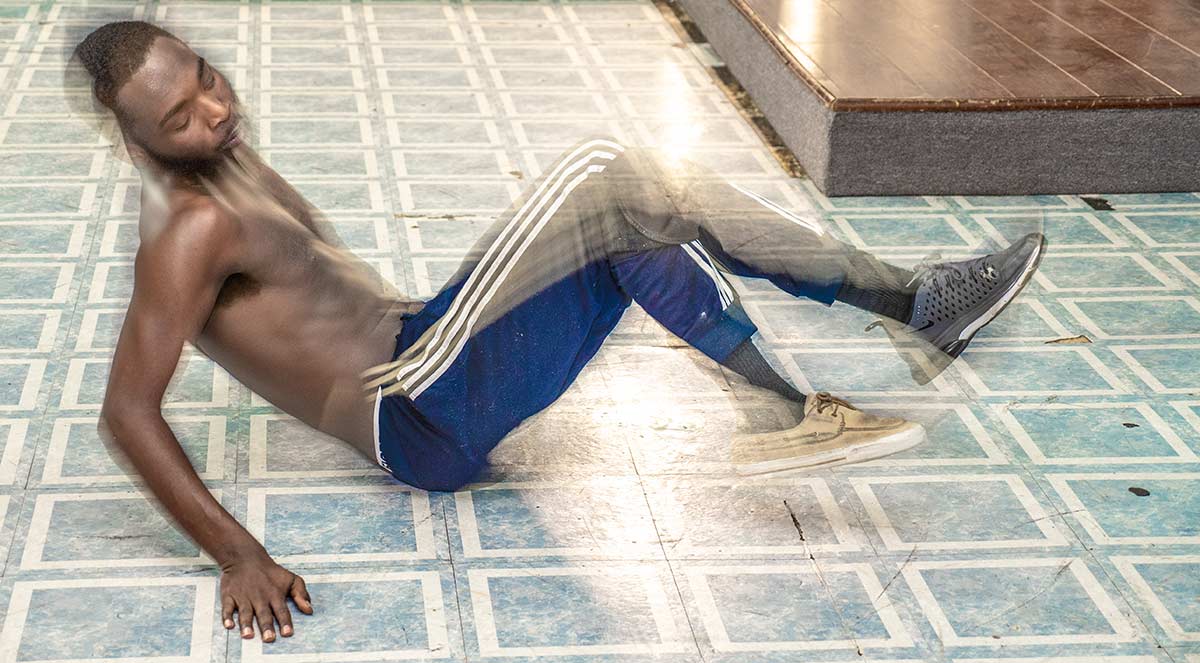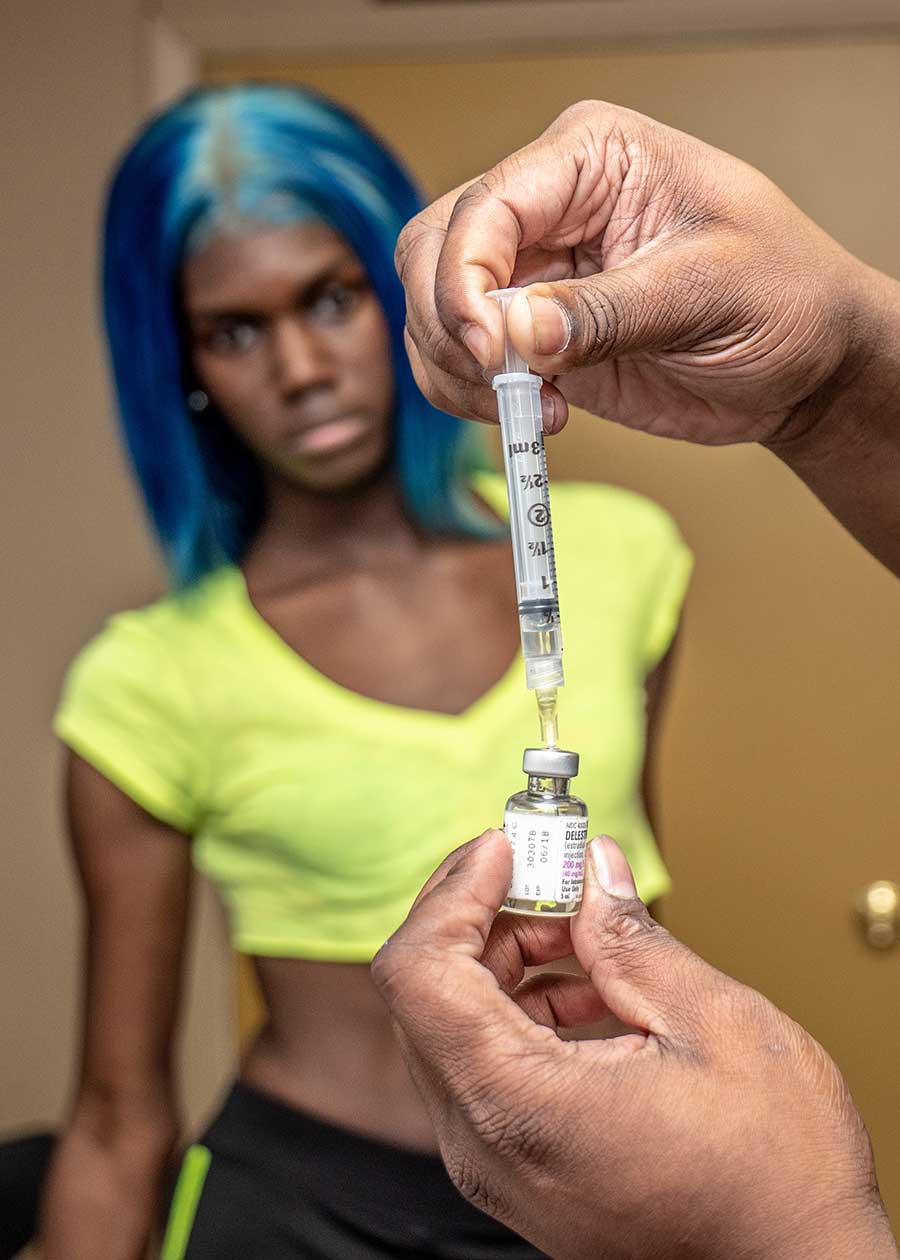In the back of a nondescript brick building on Chicago’s West Side, cool evening air drifts through a propped-open metal door. A security guard checks IDs as young people stroll into a room the size of a storefront church.
They’ll take off their sneakers and wear socks. Some will slip on high-heeled boots. It doesn’t matter that they can’t hear themselves speak over the blaring music. Here, the talking is done on the dance floor.
The Vogue School isn’t really a school—but its regulars learn plenty from one another. How to spin, dip, duck walk, catwalk, and perform other basic elements of voguing. The dance style had its mainstream moment with Madonna's 1990 hit “Vogue,” inspired by New York’s gay underground dance scene, and in the 1991 documentary Paris is Burning.
“Vogue is an expression of my feelings,” says Karma Muñez, 27, a.k.a. Karma Mizrahi, who travels from Burbank to the West Side to guide young dancers at the Vogue School and who identifies as gender non-conforming. “It helps me to relieve some stress or hurt—and it’s an outlet for young LGBT people who can’t be themselves in certain places.”
Serving mostly young and black gay men, trans women, and androgynous as well as gender-nonconforming individuals, the Vogue School is a rare resource on the West Side for those whose sexuality and gender identity could prevent them from securing amenities like housing and healthcare.
The latter, in fact, is at the core of the Vogue School’s mission. Born through the nonprofit TaskForce, which provides medical services to youth at risk of HIV and other STIs, the School began as the social arm of an otherwise medical endeavor.
Dr. Margo Bell, a onetime physician in adolescent medicine at Stroger Hospital, got involved with the nonprofit in 2006. She was working days at Stroger at the time, when she noticed many of her patients were coming in without their basic medical needs met. So three nights a week, she’d rent space on the West Side to provide medical services, like vaccinations, to neighborhood children. “It was just one room,” she says. “All from my own pocket.”
Gradually, Bell noticed something else happening: “There were a lot of disenfranchised youth, particularly LGBT youth, coming in, and we saw a need to focus on transgender youth. Once they heard we provided medical services, it just became the spot to come to.”
Bell started by providing free HIV and STI testing, and from there, it snowballed. “A lot of young people were doing street hormones,” she says, “and in order to make it safer for them, they needed to have their hormone levels measured. Sometimes I would buy the hormones.”
“It’s an opportunity to engage young people in health care without it being intrusive, mandatory, or punitive,” she adds.
As Bell got to know her patients, she learned that many of the gay and trans individuals coming by were part of the local ballroom scene, which held underground vogue dance competitions. When she saw their stuff, she knew they needed a place to practice.
“How can you stifle that creativity by not giving them the power and space to express it?” she says.
And so in 2011, with help from a grant, TaskForce executive director Alicia Ozier rented out a room next door to the clinic where LGBTQ youth could hang out, dance, and practice their ballroom moves—free from the outside world. “Eventually, they started calling it the Vogue School,” says Bell.

The space has changed considerably since its humble beginnings. Today, couches line walls painted in bright blue and pink. On a celery-green board, young people scrawl their names, hashtags, and messages of empowerment. The space houses workout equipment and a small kitchen, where the School serves chicken and pizza dinners free of charge.
At the center of it all is an iPod and massive speaker. On Mondays and Wednesdays from 6 to 9 p.m., the Vogue School opens and the music stays on.
Derius Robinson, who's been visiting the School since its inception, describes the space plainly: “A bunch of gay people that just want to come and be accepted and have fun doing what they like to do.”
Since helping to open the space, Dr. Bell has retired and moved to Texas. But the School is still in session, as are its flagship testing and referral services.
On a recent Monday night, Blue, a 20-year-old from Riverdale who works as a cook, had taken a bus and two trains 90 minutes to get to the Vogue School. Blue, who identifies as an “androgynous butch queen,” had come in for an HIV test.
“The service, the friends, the music, meeting new people—it gives you energy,” says Blue, who tested negative. “For people who don’t have that much food at home, you’re fed here. You get good memories when you come here.”

With long neon hair that would make My Little Pony jealous, 19-year-old Layla Brown has been coming to the Vogue School for just longer than a year. She already knew how to vogue, but admits, “I wasn’t up to par.”
Last summer, Brown began taking hormones as part of her transition. She currently lives with her grandmother. The rest of her family, she says, isn’t as supportive.
“They made it clear they wouldn’t be accepting of me being gay,” she says. “So of course they won’t accept me transitioning.”
“I lost my real close friend, a gay boy, to gun violence my senior year of high school,” she continues. “That’s when I realized that life’s too short. I really wanted to transition.”
Helping Brown with her transition is Nyla Balenciaga, 29, who on this night administers a hormone shot that Brown takes once every other week.
“We don’t have fancy wood floors or fancy mirrors,” says Balenciaga, “but [the Vogue School] gets the job done. The kids love coming here and that’s what it’s about.”
It may be a sparse space, but the School’s monthly tab runs around $3,000 for rent, utilities, and insurance. Dr. Bell contributes a sizable amount—about 40 percent—but says she can’t do it forever: “I’m very concerned. I don’t think there would be another safe space on the West Side for these young people.”
Bell remains in discussions with other LGBT organizations to secure grant funding for the School’s future. Still, she says, the center needs a more permanent solution: “You can’t have a place that’s totally grant dependent. We need more than one source of funding—both donors and some granting.”
Is there enough money to keep the Vogue School’s metal door propped open through year’s end? “It would be cutting it pretty close,” Bell admits.
But for now, youth like 18-year-old Jacob Gomez will have a place to hang—and prepare for his first ballroom competition.
“A lot of people think gay people in their element is all wigs, glitter, and sparkle,” says Gomez. “No. In our element, we’re free. We’re away from the world. We’re away from, ‘You’re a faggot.’ There’s none of that here. You’re home.”
Update, June 20, 2018: Alonzo Brown, the education director at TaskForce, has set up a GoFundMe page on behalf of the Vogue School. Donate here.


